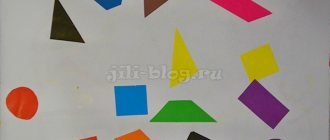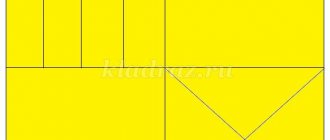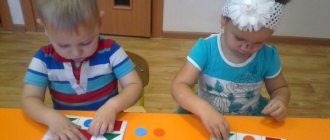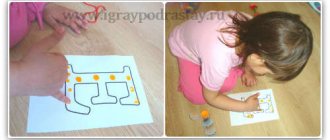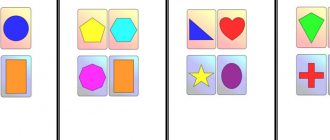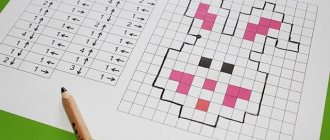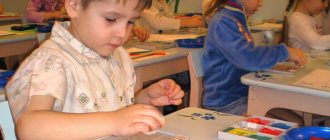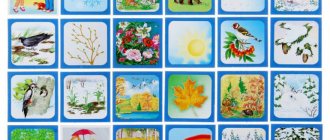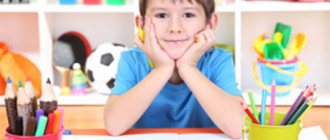Why study geometric shapes with your baby?
- Geometric shapes are found everywhere; they can be seen in most objects around us: a round ball, a rectangular table, etc. By analyzing the similarity of surrounding objects with geometric shapes, the child wonderfully trains associative and spatial thinking.
- Studying geometric shapes is useful for the overall development of the baby and expanding his knowledge about the world around him. If you introduce your child to shapes at an early age, he will have a much easier time at school.
- Many interesting educational games are based on the ability to distinguish geometric shapes. This includes construction, games with sorters, mosaics, math tablets, Dienesh blocks, etc. Therefore, studying forms at such an early age will contribute to the further successful development of the child.
So, games for learning and consolidating knowledge about geometric shapes :
What figure does the toy resemble?
Game material: many different toys, objects, SIMILAR in shape to a cube, beam, ball; a bag with geometric bodies - a cube, a beam, a ball.
Contents of the game. The student, whom the teacher called to the board, is given the task of taking one of the geometric figures out of the bag by touch and selecting the most similar ones from among the objects and toys, for example, to a ball - a BALL, to a beam - a box, etc.
Note. Instead of objects in the game, you can use cards with their images.
Name the item.
Contents of the game. Name objects that are shaped like a circle. The first student names, the rest add. For example, the student named the bottom of the glass as the last object. The teacher says: “The bottom of the glass is one, the bottom of the glass is two, the bottom of the glass...” If there is still no student who would name an object shaped like a circle, the teacher says: “Three.”
The winner is the one who named the last item.
Geometric Lotto.
Game material: cards (6 x 3 cm) divided into four equal rectangles; in each rectangle geometric shapes of different colors and differently located are drawn; envelope with geometric shapes (Fig. 52).
Contents of the game. The teacher gives each student a card and an envelope with geometric shapes. The teacher takes a figure from his envelope. One of the students calls her. The rest of the students make the corresponding shape of the same color on their cards.
The game ends when one of the students makes all the geometric shapes.
173. Lay it out correctly. Game materials: cubes, bars.
Contents of the game. The called student names the geometric shapes lying in front of him and feels them. Then the student closes his eyes and by touch puts the cubes to the left and the beams to the right. The one who never makes a mistake wins.
Find your figure.
Game material: the teacher has four large geometric shapes (square, circle, rectangle, triangle), which are clearly visible from the last desks; Students have the same geometric shapes in smaller sizes.
Contents of the game. The teacher attaches a square, rectangle, circle, triangle to the board at an equal distance from each other. Each student receives one of the geometric shapes, for example, a circle. All students who have a circle must quickly go to the board and stand one after another at the board opposite the circle. The teacher says: “Rectangle”, and students with a rectangle line up against the corresponding geometric figure, etc.
By the end of the game, the entire class should stand in four columns. There are also gape students - they remained sitting at their desks.
The column that does not make mistakes and does not have a single unwary student wins.
Wonderful bag.
Game material: bag with geometric shapes or bodies: circles, squares, rectangles. triangles, cubes, bars, balls.
Contents of the game.
Option 1. The teacher shows a circle and asks: “What is this?” “Circle,” the students answer. The teacher says: “Hold it in your hands. Without looking into the bag, find the circle by touch and take it out.”
Option 2. “Take any figure in the bag without taking it out, just by touch determine what kind of figure it is, name it, take it out, and let the guys check whether you named this figure correctly.”
Var iant 3. The teacher says: “Find the square in the bag by touch. Show it to the guys."
The winner is the one who completes all tasks correctly. He gets a star. At the end of the game, you can calculate which row received more stars, how many guys in total. class received stars.
What changed?
Game material: demonstration geometric shapes or bodies (circle, square, triangle, cube, beam, ball).
Contents of the game. The teacher places three geometric figures on the table and invites students to carefully look and remember the sequence of their location.
At the command “Eyes sleep”, students close their eyes, and the teacher quickly rearranges one or two figures or removes one figure and asks: “What has changed?”
The student must answer which figure is missing or how the arrangement of the figures has changed.
You can leave the arrangement of the figures unchanged. This always creates excitement in children.
Note. The number of simultaneously exhibited figures should be gradually increased as students develop observation and attention.
177. Visual dictation.
Game material: typesetting canvas, a set of demonstration geometric figures for each student (Fig. 53).
Contents of the game. 1. The teacher places several geometric shapes on the typesetting canvas from left to right. Students place their figures on their desks in the same order according to the model.
2. On the typesetting canvas, the teacher places figures in the form of an ornament. Students reproduce this ornament on their desks.
3. The figures are placed on the typesetting canvas for 20-30 seconds, students must REMEMBER their location and reproduce the same ornament on the desk from memory. (The number of figures should be gradually increased from two or three to five or six.)
Auditory dictations.
Game material: envelopes with a set of geometric shapes (for students) (Fig. 54, 55).
Contents of the game. 1. The teacher names geometric shapes and students must put them in the same sequence in which they named the shapes
2. The teacher not only names the figures, but also indicates their location relative to this or that figure or piece of paper. For example: “Put a circle, put it to the left of it. a triangle, a square on the right, a rectangle at the top.”
Rice. 55
“In the middle of a piece of paper, place a red circle in the upper right corner - a triangle, in the upper left corner - a square, in the lower left corner - a triangle, in the lower right corner - a square."
Another task: “How many triangles, squares, circles?”
You need to count like this: one triangle, one square, one circle, two squares, two triangles, two circles, three circles, three triangles, etc.
The one who made no mistakes and correctly counted all the pieces won.
Let's make a belt.
Game materials: red squares, green triangles, yellow circles (each student has three or four figures).
Contents of the game. Students are asked to place a square, a triangle, a circle one after another. Then, in the same sequence, they must place the next three similar figures behind these figures, then repeat the same again, etc. The result should be a multi-colored belt of three geometric shapes, which are arranged in a certain sequence (Fig. 56). The teacher checks whether the established conditions are fulfilled correctly. The winner is the one who has never made a mistake when composing the belt.
The game helps to consolidate visual images of geometric shapes, develop voluntary attention, and observation skills.
Fig.56
Geometric domino.
Geometric shapes cut from colored paper are glued onto plywood or cardboard plates. There are several options you can make.
Option 1. Two figures of the same color (two red circles, two blue triangles, two yellow rectangles, two green squares). When playing, children are guided by color, knowledge of which ensures the selection of shapes according to shape.
Option 2. All figures are the same color and the same size. When choosing pairs, children focus only on the shape of the figures.
Option 3. All the figures are the same color, but in each pair the figures are different in size (two green circles, one of THEM is large, the other is small).
Option 4. Pairs of figures of the same size, all figures of different colors.
Option 5. Only the outlines of the figures are given. Each contour figure is covered with a solid figure or object of the same shape. A saucer, coin, ring, thimble, etc. are selected for the circle.
The rules of the game are the same as in regular dominoes. 181. Doubles game.
Game material: geometric shapes - square, rectangle, circle, triangle (planar) and the contours of these shapes (Fig. 57).
Contents of the game.
Option 1. Students are given planar geometric figures and the contours of these figures.
Children, holding figures in their hands, line up in two lines facing each other. At the teacher’s command, they line up in pairs behind each other’s heads. Planar and contour figures must connect.
Fig.57
Var i a n t 2.
You can make this game a board game. Students are given cards, some have a geometric figure pasted on them, and others have an outline of the same figure. Paired cards are immediately put aside. And then the children draw cards from each other. The one who folds his cards first wins.
We name geometric shapes always and everywhere
If you come across any figure while playing or reading books, be sure to draw your baby’s attention to it and name it (“Look, the ball looks like a circle, and the cube looks like a square”). Even if it seems to you that the child is unlikely to remember the names of the figures, say them anyway, and they will definitely be imprinted in his head. You can do this for up to a year. At first, point out only the basic shapes (square, circle, triangle), then, when you understand that the baby has mastered them, begin to study other shapes.
In the land of geometric shapes
In the land of geometric shapes" (cognitive and research activities (REMS)). Senior group
Chernigovskikh E.V.,
Mulyar N.V.
educators
MBDOU DS No. 10
"Firefly", Stary Oskol
Advertising message
The logical basis of the educational situation of the OHS
Main educational goal:
form ideas about the features of volumetric figures (they have several sides of a geometric shape)
New knowledge = children's “discovery”:
to accurately determine a three-dimensional figure, you need to examine it from all sides
What concepts and methods of action need to be updated:
repeat the names of volumetric geometric shapes; repeat the shapes of flat geometric figures, their properties (color, size); train the ability to understand and use symbols, update ideas about the table
Reason for difficulty:
we don’t know how to determine a three-dimensional figure based on one side
The purpose of the activity to overcome the difficulty:
learn how to identify a three-dimensional figure (for example, by its image).
TARGET:
1) form ideas about the features of volumetric figures (they have several sides of a geometric shape);
2) to develop the experience of independently overcoming difficulties under the guidance of a teacher based on the reflexive method;
3) repeat the shapes of flat geometric figures, their properties (color, size), train the ability to understand and use symbols;
4) update ideas about a table, row and column, the ability to determine and express in speech the place of a figure in a table;
5) train mental operations - analysis, synthesis, comparison and generalization, develop attention, memory, speech, fantasy, imagination, logical thinking, initiative, creativity, fine motor skills.
MATERIALS FOR THE CLASS
Demo:
- Cards with images of symbols;
- Sample - table;
- Passports of volumetric geometric shapes;
- Geometric planar figures, bodies, modules;
- Children's cameras, 2 hoops
Dispensing:
- tables;
- geometric figures;
- cards-passports of volumetric geometric shapes.
PROGRESS OF THE CLASS
1.Introduction to the game situation.
Didactic objectives: to motivate children to engage in play activities, to cultivate a willingness to help others.
The teacher gathers the children around him.
-Children, I know that you travel a lot with your parents. Which countries have you already visited? (Turkey, Egypt, Bulgaria, Greece) But I know for sure that you were not in the same country. This is an unusual Land of geometric shapes. And today I received a letter from the residents of this country. This is what they write: “Dear guys! An emergency has occurred in our country: a strong hurricane destroyed houses, carried away residents’ documents, and we ask you for help.”
- Well, how? Are you ready to provide assistance and resettle residents in new homes? (Yes)
- Updating knowledge.
2.1. Game "Find the medallion"
Didactic tasks:
- repeat the shapes of flat geometric figures, their properties (color, size), train the ability to understand and use symbols;
- train mental operations - analysis, synthesis, comparison and generalization, develop attention and memory.
– You can get to the land of geometric shapes with the help of magic medallions, which you will find according to the card with symbols indicating the properties of the figure.
On one table there are cards with symbols, on the other there are medallions with images of geometric shapes. Using a card, children find a medallion for themselves and wear it. The teacher checks the correctness of the choice and clarifies why the child chose this particular medallion.
- Guys, let's stand in a circle and say a spell: “One, two, three - fly to the land of magic!”
Children pronounce words, “cosmic” music sounds.
- Here we are in the land of geometric shapes.
2.2 Game “Settle in the tenants”
Didactic tasks:
- ) update ideas about a table, row and column, the ability to determine and express in speech the place of a figure in a table;
- train mental operations - analysis, synthesis, comparison, develop attention, logical thinking.
- Children, the hurricane destroyed the houses of geometric shapes, let's move them into new apartments.
– What are the names of the houses in the land of geometric shapes? (Tables)
- Let's remember what the floor is called? (Line) That's right, line (first, second).
-What is the name of the entrance? (Column) Correct, column (first, second, third?
– What figures will live on the first and second lines? (small, large)
– In which column are squares, circles, triangles, rectangles located? (in the first, second, third, fourth)
Children sit at tables and lay out the figures themselves.
3. Difficulty in a game situation.
3.1 Game "Photographers"
Didactic tasks:
- create a motivational situation for the formation of ideas about the features of volumetric geometric shapes;
- to form experience, under the guidance of a teacher, of fixing a difficulty, understanding its cause and experience of goal setting;
- train mental operations - analysis, synthesis, comparison, develop attention, logical thinking.
The teacher gathers the children around him.
- Guys, you moved only geometric shapes into apartments. But other figures lost their documents—passports. They need to be restored. There is always a photograph in your passport. Can you help the figures take photos?
Children take children's cameras and “photograph” three-dimensional figures standing on the table (cube, cone, cylinder, prism)
The teacher says that the photo studio printed the photographs, but they were mixed up (the photographs are black and white).
The teacher puts cards with a picture of a circle, square, triangle, rectangle on the table and asks them to choose a photo for each figure. A difficulty arises since, for example, a rectangle can be a photograph of both a cylinder and a prism.
– Were you able to find the photographs? (No, we couldn't)
- Why couldn’t they? (The same photo suits different figures)
-What can we do to help the figures?
The teacher listens to the children's answers and leads them to the fact that it is necessary to photograph the figures so that from the photograph one can accurately determine which figure was photographed.
4.Discovery of new knowledge.
Didactic tasks:
- to develop experience in determining a three-dimensional figure; in order to accurately determine a three-dimensional figure, one must examine it from all sides;
- to form the experience of independently overcoming a difficulty and the emotional experience of the joy of discovery, to consolidate the method of action “if I don’t know something, I’ll come up with it myself, and then I’ll test myself in a textbook”;
- train self-control skills, mental operations - analysis, synthesis, comparison, develop attention, logical thinking, initiative, creativity, speech.
-How should you photograph the figures so that their differences are visible?
All the children's suggestions are listened to. The teacher leads them to understand that the figures have differences that need to be shown in the photograph.
– What is the difference between a cylinder and a prism?
At the end of the discussion, the conclusion is drawn: in order to accurately determine a three-dimensional figure, it is necessary to examine it from all sides.
The teacher shows the children a cylinder.
– What kind of photograph will be obtained if the cylinder is photographed from this side (shows the end on one side and the other)? (You will get 2 circles)
Then the teacher shows the children a drawing of the cylinder’s passport - and says that this photograph tells almost everything about the cylinder, just as a passport tells almost everything about a person. This means that this is the cylinder passport.
The teacher invites the children to break into pairs: one photographs the sides of the figure, the second turns it, then switch places. The children, together with the teacher, look at the passport photos of the figures.
- Incorporating new knowledge into the knowledge system.
5.1Game “Find the Passport”
Didactic tasks:
- consolidate ideas about volumetric geometric shapes, the ability to correlate flat geometric shapes with volumetric bodies;
- train mental operations - analysis, synthesis, comparison, develop attention, logical thinking, communication skills.
The teacher invites the children to give passports to all residents of the country of geometric shapes.
Children take passports and find the corresponding figure (cube, cylinder, prism, cone) from a three-dimensional construction set and explain their choice.
5.2 Game “Make no mistake”
Didactic tasks:
- organize active recreation for children;
- consolidate the classification of geometric shapes by color, shape, size;
- develop spatial orientation.
The teacher places 2 hoops of different colors (for example, red and yellow) on the carpet. On the table there are geometric shapes of different volume, color, and size. The teacher invites the children to take any one piece and explains the rules of the game.
- Children, you will dance to the music. As soon as the music stops playing, you take your place in the hoops. Which figures, where to stand I will tell you, be careful.
Children begin to move voluntarily.
– Large figures with a red hoop, small ones with a yellow hoop (blue-green, planar-volumetric)
6.Result of the lesson.
Didactic tasks: to reflect on activities in the classroom.
The teacher gathers the children around him.
-Where have you been today?
– How could you help the figures? (we moved the flat figures into new apartments and made new passports for the three-dimensional figures)
– Why were you able to help the figures? (to accurately determine a three-dimensional figure, you need to examine it from all sides).
The teacher praises the children and says that today they helped the residents of the country of geometric shapes move into new apartments, learned how three-dimensional shapes differ from planar ones, restored their passports, built houses,
– Children, I give you magic medallions that can always transport you to the land of geometric shapes. And now it's time for us to go back.
Children form a circle and say the words “One, two, three - Fly!”
Let's play geometric lotto
With the help of lotto you can study anything: colors, geometric shapes, vegetables, animals, etc. And geometric lotto is also quite easy to make yourself: on a sheet of paper or cardboard we draw or print two identical sets of shapes, one of which we cut into cards. Everything is ready, you can play. Our lotto templates for learning geometric shapes can be used.
For the first lessons with your baby, it is better to use lotto, which has only 3-4 figures. When your child masters this game well, gradually complicate the task. It is also useful for the first time to make all the figures on the playing field the same color and size. In this case, the child will be guided by only one sign - shape, while other characteristics will neither distract nor prompt him.
You can place both cards with images of figures and three-dimensional figures on the playing field. Dienesh blocks (Ozon, KoroBoom), figures from a sorter, and insert frames are well suited for this purpose.
Well, the easiest option is to purchase a ready-made lotto with geometric shapes.
Math lesson in 4th grade “Cone”
Lesson topic: “Cone”
1st lesson on the topic “Cone”
Lesson type:
formation of new knowledge.
Target:
formation of educational competencies (informational, communicative, reflective) of 4th grade students in the subject area “Mathematics” on the topic “Cone”
Learning objectives aimed at achieving personal results:
— formation of motivation for learning and purposeful cognitive activity;
- formation of a respectful attitude towards other opinions, towards another point of view.
Learning objectives aimed at achieving meta-subject learning outcomes:
Cognitive:
- identify the essence and features of objects;
- generalize and classify according to characteristics.
Regulatory:
— develop the ability to predict upcoming work (make a plan);
- develop the ability to express your assumptions based on working with the textbook material;
— to develop the ability to carry out cognitive and communicative reflection.
Communicative:
- develop the ability to listen and understand others;
- express your thoughts orally.
Learning objectives aimed at achieving subject learning outcomes:
— develop the ability to recognize the geometric figure “Cone”;
Planned result: be able to find the geometric figure of a cone and its parts.
Basic concepts:
“cone”, “top of the cone”, “side surface”, “base”.
Working methods:
- partially search engines
- verbal
- visual
- practical
Equipment:
Computer, projector, handouts, presentation.
Resources:
• basic: textbook “mathematics” 4th grade, workbook on mathematics 4th grade.
During the classes
- Organizational moment
- Setting the lesson goal. Reception "Circles on the water."
- Problem formation, activity planning.
A game:
The teacher blindfolds the student and gives him a figure (cube, parallelepiped, ball, pyramid, cone). The student names the figure and gives it a description.
Or
-Let's play the game “Wonderful Bag” (“Black Box”). You must determine by touch what kind of figure you have in your hands. And tell everything you know about her.
Now I’ll read you a riddle, try to guess what it’s about?
Here is the cap on the head -
This is a clown on the grass.
But the cap is not a pyramid
This is immediately obvious, brothers:
Circle at the base of the cap.
What should he be called then? (Cone).
- That's right guys, cone. Then tell me, what is the topic of our lesson today? That's right, familiarity with the geometric figure - the cone.
- What is the goal of our activities?
(Learn the distinctive features of the CONE figure and where the CONE figure occurs in life).
- And to achieve the goal we need the ability to work in pairs and with a textbook.
- Discovery of new knowledge.
Historical reference:
- Why is it called that? Do you know that people have been familiar with the cone since ancient times. The word "cone" comes from the Greek word "konos" - "pine cone".
- Look at the Cone, does this figure have a vertex? (Yes 1)
What about the edges? (no, there are no side edges, there is just a side surface)
What does the base look like? (per circle).
A cone is a body that consists of a circle (the base of the cone), a point not lying in the plane of this circle (the top of the cone) and all the segments connecting the top of the cone with the points of the base.
Open the textbook on p. 21. A cone has a base - a circle and a lateral surface.
- So, guys, what did you learn about the cone as a result of observation?
(This is a figure that has 1 vertex, no side faces, only a side surface and a circle at the base.)
- Guys, what shape does the cone most resemble? (on the pyramid)
- Let's compare these two figures, what they have in common and how they are different.
— In the world, a huge number of things are shaped like a cone. Often we don't even notice them. Road cones warning of road works, the roofs of castles and houses, ice cream cones - all these objects are shaped like a cone.
In nature there are enough objects that have the shape of a cone: a spruce, a mountain, an anthill.
- Name objects that have the shape of a cone (children name them).
- Physical education minute
Triangle - walk,
Rectangle - squat
Well, if the circle is a friend,
Performing a quick jump.
- Skill development – application of knowledge.
Working in the workbook pages 12 – 13
- Now let's see how you remember the distinctive features of the cone, open RT to page 12, No. 31,32
- Checking a completed task
-What shapes did you paint? (2, 4) Prove that this is really a cone.
— No. 32, check yourself to see if you painted the base of the cone correctly.
Checking a classmate’s work in pairs (mutual checking).
- Now we will make the side surface of the cone. There are blanks on your desk. Place the edges one on top of the other to create a conical shape. Glue the edges.
- You have all got the side surface of a cone, look at task No. 4 from 22 in the textbook. What objects or parts of them are similar in shape to the side surface of a cone?
- Your task is to come up with objects at home that look like the side surface of a cone.
- Lesson summary.
- What new did you learn? What is a cone? What does it consist of? What kind of cone is there? Why are cone-shaped objects?
- Reflection on activity (lesson summary)
- Homework.
— Thank you all for your work, the lesson is over.
Playing with the sorter
At about the age of 1 year, the child begins to notice that the sorter figurine he has chosen (Ozone, Labyrinth, My-shop) cannot be pushed into every hole. Therefore, during the game it is necessary to focus on this: “So, here we have a circle - it doesn’t fit here, it doesn’t fit here, but where does it fit?” At first, turning the figure at the right angle may be a little difficult for the baby, but it’s not scary, it’s a matter of practice. The main thing is, do not forget to pronounce the names of the figures all the time during the exciting process of “pushing”, and the child will quietly remember them all.
Important! When choosing a sorter, pay attention to the fact that all the basic geometric shapes are represented there, and not just hearts and crescents.
Sorting geometric shapes
The process of sorting objects began to interest my daughter at the age of 1 year 4 months. We sorted items by color, size and, of course, shape. I think Taisiya really liked this game because we often involved her toy friends in it. As soon as the doll Masha was invited to play, for example, she immediately reported that she liked to play only with triangles, and the bear said that he only liked rectangles. So we had to carefully select the figures so as not to offend anyone :)
Cones in nature
Some things cannot be seen, such as a termite mound from the inside.
Moreover, it has amazing strength. In cross-section, the internal space of a termite mound is similar to a cone. Most anthills and hills, embankments that are many tens or thousands of years old, snow and sandy slopes in shape resemble the geometric body in question, sometimes with a small height and a large radius of the base, sometimes truncated.
Think of cones from spruce, cedar or pine.
Everyone enjoyed the taste of mushrooms.
The crown of a Christmas tree, pine and other coniferous trees expands from top to bottom.
Anyone who has been to the sea remembers these beautiful shells that create the sound of the surf.
Even poisonous mollusks look like cones consisting of sections.
The inflorescences of polygonums, legumes (lupine) and other plants expand downwards.
Echinacea drops its petals when it finishes flowering.
Many nuts and seeds look like cones, including double ones (acorns).
Stalactites and stalagmites in caves, icicles hanging from the roofs of buildings, carrots - all expand from bottom to top or, conversely, narrow.
Volcanoes also look like they are truncated by a plane parallel to the base.
When the ground collapses, so-called karst sinkholes are formed, or long-abandoned pits crumble. How do they look? Occasionally close to the cylinder, but mostly widen towards the top.
Let's draw
When drawing together with your child, do not forget to say the names of the shapes. “So, let’s draw a square, now a triangle - we get a house,” “Let’s draw a circle, an oval, a stick, a stick - we get a little man.”
From about 1.5 years old, the child can already be asked to trace figures using stencils. You can make the first stencils with geometric shapes yourself from thick cardboard, because... ready-made stencils, as a rule, are very small for the very first drawing experiments. I made the first stencils for Taisiya from a not very successful set of cards (the pictures were not very good, but the cardboard was excellent), four main figures were enough for us (the size of our stencils is 8x8 cm).
At the age of 2, Taisiya fell in love with drawing using small stencils (another option), and at this age we began to trace the outside of Dienesh blocks, it was no less interesting, although more difficult.
We glue
You can use geometric shapes in appliqué classes from the very first lesson. When a baby is just getting acquainted with glue (in my opinion, familiarization goes well between the ages of 1 year and 2-3 months), he is more interested in the gluing process itself than in creating some kind of composition. Therefore, you should not create complex pictures in the first applications with your baby; start simply by chaotically gluing pieces of paper onto a piece of paper, or even better, by chaotically gluing geometric shapes! While the baby enthusiastically smears the figurine with glue (with your help) and places it on a piece of paper, you tell him what it is called. With such a game, all the names fit very well in the baby’s head, one might say, they “stick” firmly.
When the baby can already glue applique elements to given places (from about 1.5 years old), you can try to create a simple composition.
You can also use various ready-made aids in your classes, for example:
- School of the Seven Dwarfs 1+. Shape, color (Ozon, My-shop)
- Educational stickers for kids. Form (Ozon, My-shop)
- Wonderful stickers. Fun geometry (Ozon, My-shop)
Finding objects that are similar in shape
For slightly older children (from 1 year 6–9 months), it is very useful to draw analogies between geometric shapes and surrounding objects. While reading and playing, on a walk, draw your child’s attention to the fact that the plate is a circle, the window is a rectangle, and the sandbox is a square, etc. In this way, you will contribute to the development of the child’s spatial and associative thinking.
You can also complete tasks to find objects in a picture that correspond to a given figure, for example, “Find all the round objects.” Several tasks are possible.
Here is another interesting shape recognition game - “Find a similar shape” (Labyrinth, My-shop). Despite the fact that the age indicated on it is 3-5 years, it will be of interest to a child of 2 years old and even a little earlier.
Didactic game “Find an object of the same shape”
Purpose: to teach to distinguish objects by shape, to distinguish and name some
geometric figures;
develop visual perception, memory, imagination, fine
motor skills, speech.
Equipment: playing field, cards with subject pictures.
Game rule: take only one card at a time, find the right place for it
and only then take another one.
Progress of the game:
The teacher examines the playing field with the child and discusses the pictures: “Look, a watermelon. It resembles a circle in shape. The watermelon is round!” etc. Explain to the child the meaning of the game: “Here is a watermelon, it’s round. Find a suitable card and place it on top. Now let's find cards that depict round-shaped objects and close the empty cells. Which drawings will you choose? Right! This is a watermelon, a wheel, a ball and a button."
You can make the task more difficult. Ask your child to select cards with matching pictures for the geometric shapes.
During the game, the child will remember geometric shapes, learn to distinguish them, and compare surrounding objects by shape.
Didactic game “What does it look like?” - find objects of similar geometric shapes in the environment.
PRACTICAL TASK No. 23.
Educational area: cognition - a type of direct educational activity: the formation of elementary mathematical concepts.
Goal: generalization of previously acquired knowledge about geometric shapes and their properties.
Tasks:
• teach the ability to find geometric shapes in the surrounding space; visual recognition and transformation of geometric figures, recreating them from representation and description.
• promote the development of spatial concepts, figurative and logical thinking, creative imagination;
• cultivate children's interest in geometry and skills of working in groups.
Methodical techniques:
Verbal: explanation, reminder, clarification, assessment of children’s activities, instructions, conversation, artistic expression, questions.
Visual: showing pictures with geometric shapes.
Practical: coloring drawings, highlighting and counting figures, constructing objects according to pre-prepared sketches and templates, working with signal cards, physics. just a minute, finger gymnastics.
Gaming: creating a gaming situation.
Problematic: help Masha and the Bear put together a picture, get home.
Integration of areas:
cognition: (to improve children’s counting skills, to practice counting within 10, to teach how to construct objects from geometric shapes, to learn to recognize geometric shapes in surrounding objects);
health: consolidate the acquired knowledge with children through a set of games, dynamic breaks, and practical exercises; help improve the overall performance of children, relieve mental stress, and easily switch from one type of activity to another;
socialization: encourage children to engage in a joint play situation with adults, develop emotional responsiveness and goodwill;
communication: master basic skills of speech etiquette; fiction: reading poems and riddles about geometric shapes;
artistic creativity: drawing kittens using geometric shapes, coloring books with colored pencils.
Equipment:
• for the teacher – computer, projector, multimedia board, pictures of geometric shapes, visual aids with shapes, pictures with fairy-tale characters;
• for children – coloring books, colored pencils, a set of geometric shapes-templates, cards with numbers.
Direct educational activities.
Org. moment.
Masha and the Bear came to our lesson today . They did not come empty-handed, but prepared tasks and questions for us to which we must find the correct answers. If we answer correctly, we will earn prizes from our heroes. 1) Riddle: My little brother, Seryozha, Mathematician and draftsman - On Baba Shura’s table Draws all sorts of... (figures)
— Our lesson is devoted to geometric shapes. Let's remember what geometric figures we know (the teacher shows drawings of the figures and reads a poem).
| He's been a friend of mine for a long time, Every angle in him is straight, All four sides are the same length, I'm glad to introduce myself to you, but my name is... (square!) | |
| We stretched out the square and presented it to the eye, Who did it look like or something very similar? Not a brick, not a triangle - Became a square... (rectangle). | |
| Three peaks are visible here, Three corners, three sides - Well, perhaps that’s enough! - What do you see? - …(triangle) | |
| A watermelon slice is a semicircle, half a circle, part of it, a piece. Knowing about forms is very important, friend. No wonder it is among these lines! | |
| If I took a circle, squeezed it a little on both sides, answer children together - It would turn out ... (oval) | |
| The wheel rolled, After all, it resembles, Like a visual nature, Only a round figure. Did you guess it, dear friend? Well, of course, this is... (circle). | |
| They filed the triangle and got a figure: Two obtuse angles inside and two acute ones - look. Not a square, not a triangle, but similar to a polygon (trapezoid). | |
| A slightly flattened square Invites to identify: An acute angle and an obtuse one Eternally linked by fate. Have you guessed what it's all about? What should we call the figure? (rhombus). | |
| Look at the six obtuse angles inside the figure and imagine that from the square you got his brother. There are too many angles here, are you ready to name it? (hexagon) | |
| How can we avoid turning it? There are exactly six equal faces. We can play lotto with him, We’ll just be careful: He’s neither affectionate nor rude Because it’s... (cube). | |
| We get down to business again, We study the body again: Maybe it can become a ball And fly a little. Very round, not oval. Did you guess it? This is... (ball). | |
| Cover on top, bottom on bottom. Two circles were connected and a figure was obtained. What should we call the body? We need to quickly guess (cylinder). | |
| Here is a cap on the head - This is a clown on the grass. But the cap is not a pyramid. This, brothers, is immediately obvious: The circle is at the base of the cap. What should he be called then? (cone). | |
| The Egyptians put them together and crafted them so cleverly that they stand for centuries. Guess for yourself, children, what kind of bodies are these, Where is the top visible to everyone? Did you guess it? Because of the view, Everyone knows... (pyramid). |
2) Logical tasks:
Name the figures. Which one is the odd one out? Why? Name the color of each shape.
- What do these figures have in common? What is the difference? Find two identical figures. What signs of triangles do you know?
-What are the names of the figures? What do they have in common? Which figure is the odd one out and why? Which of the figures is the largest? Which one is the smallest?
2. Physical education lesson (performed according to the drawing on the board)
How many dots are in this circle, How many times will we raise our hands.
How many sticks to the point, How many will we stand on our tiptoes.
There are so many green Christmas trees, so many bends we can make.
How many circles we have here, How many jumps we will make.
· Game “Fold the picture”. — Masha and the Bear offer to put together pictures of geometric shapes using ready-made cards. To do this, we will split into two groups. Each group will create their own picture. But first, let's take a closer look at the cards. Name the geometric shapes from which the pictures are composed. How many figures are there in total? What color are the figures? First you need to put the picture together, looking at the card, and then from memory.
Riddles from Masha and the Bear.
Look at the figure and draw three corners in the album. Connect the three sides together. The result was not a square, but a beautiful... (triangle).
I am a figure - no matter where, Always very even, All angles in me are equal And four sides. Kubik is my beloved brother, Because I…. (square).
It looks like an egg or your face. This is the circle - It has a very strange appearance: The circle has become flattened.
It turned out suddenly... (oval).
Like a plate, like a wreath, Like a cheerful bun, Like wheels, like rings, Like a pie from a warm oven! (circle)
A slightly flattened square Invites to identify: An acute angle and an obtuse one Eternally linked by fate. Have you guessed what it's all about? What should we call the figure? (rhombus).
This figure is the brother of our square, but only two sides are equal, and the angles are all the same... (rectangle)
5. Finger game “Kittens” (author: Pakhomova E.V.) (We fold our palms, press our fingers together. Elbows rest on the table) Our cat has ten kittens, (We shake our hands without separating them). Now all the kittens are standing in pairs: Two fat, two dexterous, Two long, two cunning, Two small and the most beautiful. (Tap the corresponding fingers against each other from the big to the little finger).
- Compare the kittens. How are they similar and how are they different? - Count how many triangles there are in the picture? - How many circles? — Try to draw your kittens. You can use other shapes.
6. Practical work “Geometric coloring”.
- Masha and the Bear ask you to color the picture with colored pencils and count how many geometric shapes you have found. — How many circles? — How many triangles? — How many squares? — How many rectangles?
7. Test of knowledge. — Children, Masha and the Bear really liked how you worked in class today. They have prepared a surprise for you. And now they need to go back. But our heroes forgot the way. Let's help them get home. And a map on which objects are depicted as geometric shapes will help us with this. - How do we get across the river? (on the bridge or on the boat) - What geometric shapes did we see? (semicircle, trapezoid) - What figure is the path in the forest depicted in? (curved line) - On the way we came across a lake, what figure is it depicted with? (oval) - Does the path around the lake lead past a flower meadow? What figure is she depicted in? (around) - So we came to the Bear’s house. What figure represents the fence near the house? (broken line) - What figures is the Bear’s house made of? (rectangles, triangle, circles). Well done guys, you did a great job!
8. Summary of the lesson, reflection. - Our lesson has come to an end. Let's remember what we did today? What was difficult for you? What did you like most? What didn't you like? - Evaluate yourself. If you enjoyed the activity and are happy with your work, raise the green circle. If you didn’t like it and you’re not happy with something, raise the yellow circle. — Masha and the Bear are grateful to you for your help. They have prepared a sweet prize for you (candy, fruit).
PRACTICAL TASK No. 24.
Didactic games for children of middle and senior preschool age (2 each) for transfiguration, laying out geometric figures from sticks.
"Make it up from sticks"
Purpose of the game: to train children in making geometric shapes from counting sticks.
Material: counting sticks.
Progress of the game: Preschoolers are trained in making geometric shapes from counting sticks.
1. “Make a figure from three (four, five, six) sticks.”
2. “Make two equal triangles from five sticks.”
3. “Build three squares from ten sticks (by attaching one figure to another).”
Learning forms using Doman cards
In fact, I believe that this method of studying forms is the most effective. If you study using Doman cards, your child will very quickly remember all the figures, and you will spend a minimum of effort on it. However, it should be noted that in order for the knowledge gained from Doman’s cards to be deposited in the baby’s head, it needs to be consolidated through other games (see above). Otherwise, the child will quickly forget everything you showed him. Therefore, I recommend starting to look at Doman cards with geometric shapes at about the age of 1 year, since at this time the baby becomes interested in sorters, insert frames, drawing, appliqué, etc. And, having studied the forms from the pictures, he will be able to use the acquired knowledge in these games. By the way, you can buy cards “Geometric Shapes” HERE.
You can read about our experience of studying figures using Doman cards here.
More of our Doman cards using the “Prodigy from the Diaper” method:
- Alphabet for children using the Doman method
- Set of cards “Letters”
- Cards - Learning to read according to Doman
- Doman Cards - Counting from 1 to 20
- Doman Colors Cards
- Doman Vegetables Cards
- Doman Berries Cards
- Doman Nuts Cards
- Cards Domana Fruits
- Domana Mushroom Cards
- Doman Cards Wild Animals
- Doman cards Pets and birds
- Doman cards Exotic animals
- Doman Birds Cards
- Doman cards Amphibians and reptiles
- Doman Cards Insects
- Doman Butterfly Cards
- Doman Cards Cat Breeds
- Doman Cards Dog Breeds
- Doman cards Underwater world and fish
- Doman Cards Flowers
- Doman Cards Wildflowers-Herbs
- Doman Nature Cards
- Doman cards Natural phenomena
- Doman Cards Toys
- Doman cards Children's creativity
- Doman cards Household appliances
- Cards Domana Furniture
- Domana Cards Tableware
- Doman Clothes Cards
- Doman Cards Shoes
- Doman cards Flat geometric shapes
- Doman cards Volumetric geometric shapes
- Domana Food Cards
- Doman cards Desserts and baked goods
- Doman cards National dishes
- Domana Drinks Cards
- Doman cards On a walk
- Doman Professions Cards
- Doman Cards Transport-1: Ground transport
- Doman Transport-2 cards: Special equipment
- Doman Transport-3 cards: Rail transport
- Doman Transport-4 Cards: Air Transport
- Doman Transport-5 Cards: Water Transport
- Doman cards Sports equipment
- Doman cards musical instruments
- Doman Cards House-Interior
- Doman Cards Home-Personal Items
- Doman Cards House-Household Items
- Doman Math Cards
- Doman Cards Body Parts
- Doman Cards Verbs (actions)
- Doman cards Sights of Russia
- Doman cards World attractions
- Doman Cards Paintings of Great Artists
- Doman Cards Tools
- Doman Cosmos Cards
- Doman's cards "What did man come up with"
- Doman cards “Outstanding Personalities”
- Supercards according to Doman’s method “Wunderkind from the Diaper”, set - “Reading while walking”
- Supercards according to Doman’s method “Wunderkind from the Diaper”, set - “Reading on the street”
- Supercards according to Doman’s method “Wunderkind from the Diaper”, set - “Reading in the Closet”
- Supercards according to Doman’s method “Wunderkind from the Diaper”, set - “Reading in the nursery”
- Supercards according to Doman’s method “Wunderkind from the cradle”, set – “Reading in the kitchen”
- Supercards according to Doman’s method “Wunderkind from the cradle”, set – “Reading at home”
- LARGE set of Doman cards “My first knowledge” for babies from 6 months to 1 year
